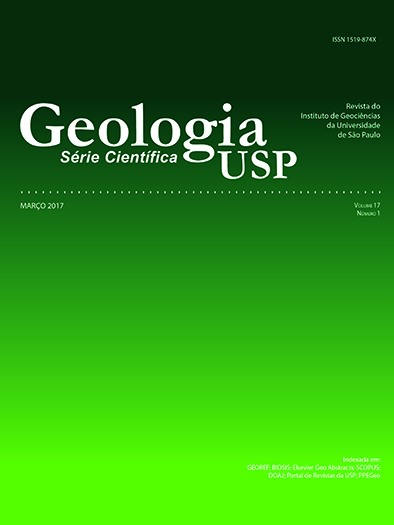Metamorfismo de temperatura ultra-alta de granulitos com safirina de 2,0 Ga do Bloco Itabuna-Salvador-Curaçá, Bahia, Brasil
DOI:
https://doi.org/10.11606/issn.2316-9095.v17-287Palavras-chave:
Granulito com safirina, Geotermobarometria, Palaeoproterozoico, Bloco Itabuna-Salvador-Curaçá.Resumo
A área de pesquisa se situa no Cráton do São Francisco, no sul da Bahia, Brasil. Nessa região, no segmento crustal Bloco Itabuna-Salvador-Curaçá (BISC), ocorrem rochas supracrustais associadas a gnaisses tonalíticos/trondhjemíticos a monzoníticos e rochas máficas subordinadas, de idades arqueana e paleoproterozoica, todos fortemente deformados e reequilibrados na fácies granulito em 2,07 a 2,08 Ga. As rochas supracrustais incluem granulitos com safirina constituídos por quartzo, ortopiroxênio, silimanita, granada, mesopertita, plagioclásio, biotita e cordierita. Com base nos arranjos microestruturais entre os minerais constituintes dos granulitos com safirina, a paragênese de pico metamórfico é Grt1 + Opx1 + Bt1 + Qtz + Sil1 + Spr1 + Mp. Microestruturas de reações entre minerais, como coroas de simplectitos ao redor de porfiroblastos, permitiram identificar as seguintes paragêneses retrógradas, interpretadas como formadas durante a ascensão tectônica dessas rochas: Grt1 ± Qtz = Opx2 + Sil2, Grt1 = Opx2 + Spr2 (+ Sil2); Opx1 + Sil1 + Qtz = Crd e Grt1 + Qtz = Opx3 + Crd. Por sua vez, simplectitos de Bt2 + Qtz formados pela reação Opx1-2 + Mp + H2O = Bt2 + Qtz estão relacionados à evolução retrógrada durante resfriamento. Cálculos termobarométricos realizados com aplicação de termobarômetros clássicos e método de multiequilíbrios (THERMOCALC, por exemplo) indicaram P = 7-11 kbar e T ≥ 900°C para os granulitos com safirina. Um dos mecanismos associados à elevada temperatura está relacionado à adição de material radioativo com a presença de magmas basálticos durante a formação do BISC. A cristalização fracionada desses magmas produziu intrusões tonalíticas que datam de aproximadamente de 2,15 a 2,13 Ga, próximo do pico do metamorfismo de 2,07 a 2,08 Ga.
Downloads
Publicado
Edição
Seção
Licença
Autores que publicam nesta revista concordam com os seguintes termos:
- Autores mantém os direitos autorais e concedem à revista Geologia USP. Série Científica, o direito de primeira publicação, com o trabalho sob a licença Creative Commons BY-NC-SA (resumo da Licença: https://creativecommons.org/licenses/by-nc-sa/4.0 | texto completo da licença: https://creativecommons.org/licenses/by-nc-sa/4.0/legalcode) que permite o compartilhamento do trabalho de forma não comercial e conferindo os devidos créditos autorais da primeira publicação nesta revista.
- Autores têm autorização para assumir contratos adicionais separadamente, para distribuição não-exclusiva da versão do trabalho publicada nesta revista (publicar em repositório institucional ou como capítulo de livro), conferindo os devidos créditos autorais da primeira publicação nesta revista.
- Autores têm permissão e são estimulados a publicar e distribuir seu trabalho online (em repositórios institucionais ou na sua página pessoal) a qualquer ponto antes ou durante o processo editorial, uma vez que isso pode gerar alterações produtivas, bem como aumentar o impacto e a citação do trabalho publicado (Veja O efeito do Acesso Aberto e downloads no impacto das citações).















